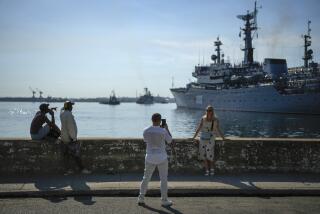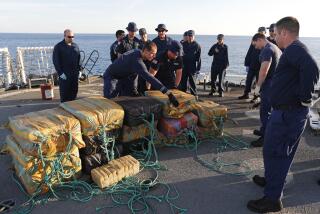Colombia Seizes Traffickers’ Submarine
- Share via
BOGOTA, Colombia — They have smuggled cocaine in high-speed boats, low-flying planes and even in the centers of lollipops. But on Thursday, Colombia’s audacious drug traffickers astounded even the country’s seasoned police.
A narco-submarine was discovered in a mountain workshop just 18 miles west of Bogota, Colombia’s capital, police announced. Aided by intelligence from the U.S. Drug Enforcement Administration, stunned Colombian police found Russian-language manuals along with the partly constructed submarine. If completed, the vessel could have transported 11 tons of cargo, Colombian naval officials said.
“Never in my life, in 32 years working with the police, have I seen anything like this,” said Leo Arreguin, DEA director for Colombia, at the improvised dry dock.
The submarine is an ambitious leap for the traffickers from fast boats and radar-dodging planes to the sort of technological tool that only a sovereign naval force usually commands.
Its appearance strengthens the position of anti-narcotics warriors, such as U.S. anti-drug czar Gen. Barry R. McCaffrey, who supported a recently approved $1.3-billion aid package with the argument that Colombia desperately needs help to stand up to well-connected drug rings with virtually unlimited budgets.
“It was shocking to me to see how much technology illicit money can buy,” said Capt. Ismael Idrobo, projects director for the Colombian Naval Academy.
The workshop’s location high in the Andean Mountains led police to deduce that the traffickers planned to transport the 100-foot vessel to the coast piece by piece in containers.
The Russian instruction manuals with Spanish translations that police found in the warehouse suggested that Russians may have been helping to build the sub, officials said, and also seemed to implicate two Americans.
Asked about involvement of Americans, Arreguin said, “We’re going to continue with intelligence efforts to find out who they are.”
There was no one at the site when police raided it, and no arrests were made. Arreguin would not elaborate further on why Americans were suspected of involvement.
Still, such loose ends were overshadowed by the discovery of the submarine.
Customs authorities have found cocaine and heroin sewn into wigs, inserted under animals’ skin, hidden in breast implants and taped inside musical instruments. Earlier this year, authorities came across several hundred fruit-flavored lollipops with cocaine centers.
Employing human carriers to swallow dozens of tightly packed cocaine capsules for transport to foreign countries has become such a common smuggling method that it only raises eyebrows when the carriers are children.
Even by Colombian standards, though, the submarine was in a league of its own.
Ernesto Gilibert, the national police chief, emphasized the sophisticated workmanship on display at the submarine construction site. Police had to overcome a closed-circuit TV security surveillance system when they raided it late Wednesday. Once inside, they found a watertight hatchway, already completed, along with the submarine’s casing, stabilizers and a propeller.
“The material all appears to be imported,” Gilibert told reporters. “The technology is advanced, and the workmanship is high quality.”
Initial police reports estimated that the completed sub would have been able to travel at 8 to 10 knots. According to intelligence reports cited in a police bulletin, “The organization [building the sub] had already invested $5 million, and was expecting at least another $5 million for motors and a machine room.”
A naval spokesman said traffickers have used smaller, relatively unsophisticated “mini-subs” to transport drugs in the past. But the vessel under construction was three times the size of the largest mini-sub, which was found five years ago, naval authorities said.
“This is a huge leap,” Idrobo said. The sub had hydraulic tubing, a protected propeller, a double hull and diving rudders that would allow it to descend to 325 feet, he said.
The submarine is considerably smaller than the used sub that a Russian immigrant in Miami allegedly attempted to broker in a $35-million deal between the Russian underworld and a Colombian cocaine cartel in 1995, according to court documents filed in Florida. That deal was never completed.
Colombia has two coastlines, one on the Pacific Ocean and one on the Caribbean, making it an ideal shipping point for some of the world’s most powerful drug cartels.
More to Read
Sign up for Essential California
The most important California stories and recommendations in your inbox every morning.
You may occasionally receive promotional content from the Los Angeles Times.













